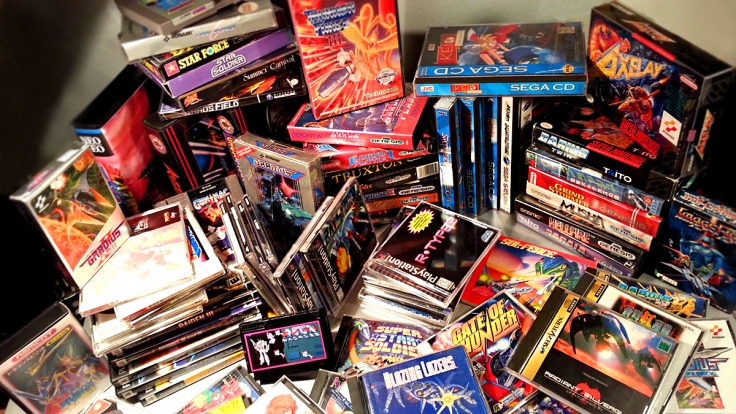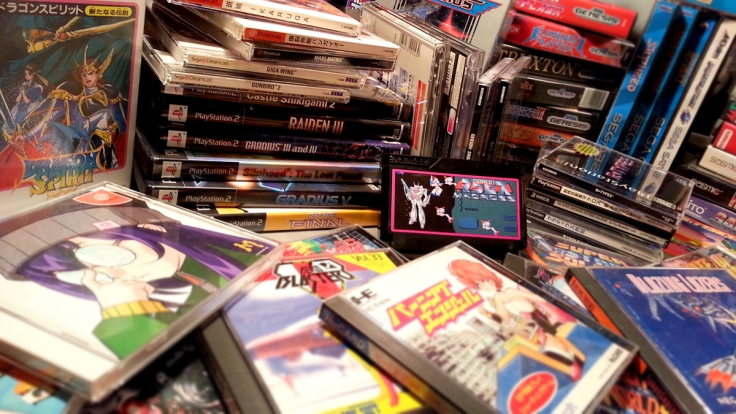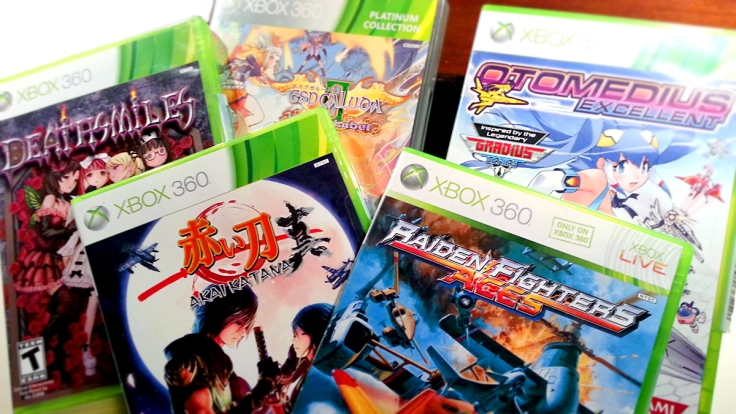
It seems that no matter what game genre we “retro” or “classic” gamers may cite as our favorite — be it platformers, maze games, puzzle games, fighting games, etc. — the shmup, or shootemup, or STG, or shooting game, or scrolling shooter, or whatever you want to call it, is almost universally revered. Despite the various strengths and weaknesses of individual titles, the shmup, as a genre, seems to be beyond reproach for many retro gamers.
Whyzzat??
Well, I cannot speak for anyone else, but I can count myself amongst them. I’ve been a fan of shmups for a long time. Dating back to non-scrolling classics like Space Invaders and Galaxian, evolving into Xevious (the grandaddy of ’em all, spawning countless imitators in Japanese arcades and launching the true scrolling shootemup format), and continuing with the myriad great titles on the 8- and 16-bit consoles before becoming the “bullet hell” genre we know today, I’ve always liked blowin’ stuff up, and I think most other gamers do too.
Even though I’d been shooting aliens and spaceships since Space Invaders, Megamania, and Vanguard on the Atari 2600, and I enjoyed games like the Gradius series on the NES and SNES, the first scrolling shmup that really grabbed me and made me realize how truly beautifully-presented the genre could be was ThunderForce III, by Technosoft for the Sega Genesis/Mega Drive. Everything from the graphics to the music and sound effects to the control seemed really polished, satisfying, and fun, and it still holds up to this day as an all-time great (and personal favorite).

From there, the Genesis, Sega CD, TurboGrafx/PC Engine, and Super Famicom/SNES explored the STG style as far as possible, while in the arcades, developers like Toaplan and Psikyo continued to intensify the genre until we ended up with the danmaku, aka bullet hell, style (many fans consider Toaplan’s Batsugun to be the first true bullet hell shmup). Nowadays, a game like 1942 seems quaint compared to the scenery-obscuring blooms of pink bullets that players are expected to snake between whilst pouring forth their own assault of hot weapon fire in their favorite shooter by Cave.
But what is it about shmups that make so many gamers obsess over them, collect them, and strive to 1CC (“1 credit clear”) them? A collection of them across home consoles is admirable; a Japanese candy cabinet or three running a collection of original Toaplan or Cave PCBs is a lofty goal, worthy of awestruck adulation. You just don’t see that sort of dedication to, say, scrolling beat-’em-ups or puzzle games. Even one-on-one fighters, despite having an entire scene of their own with high-profile tournaments, don’t seem to carry the badge of hardcore dedication to gaming that shmups do. (Speaking of that, where are the EVO-sized shmup tournaments?? That needs to be a thing.)

I think it may be because the shmup has such a traceable lineage all the way back to the first hit Japanese videogame, Space Invaders. A single player ship against a swarm of enemies is the oldest videogame concept that’s still being used today. I mean, there aren’t exactly a whole lot of Pong-based games coming out these days, like there were in the ’70s. Other popular genres of video games’ Golden Age, such as the maze-chase game and the climbing game (offshoots of Pac-Man and Donkey Kong, respectively), both of which there were oodles, are not even a thing anymore (with the exception of the occasional reimagining of Pac-Man itself, such as Pac-Man Championship Edition or Pac-Man Battle Royale). Shooting games, though? Still hot as ever. So with every new title, classic game lovers can still get new twists on the simple you-against-them shootemup that we’ve been enjoying for 40 years now.
Continuing on the trajectory of simplicity, then, is the fact that a shmup is easy to understand; possibly easier than any other current gaming genre. Even if you don’t grasp the finer details of a particular title’s system, you know that the rules will be little more than “shoot stuff and dodge bullets.” There will be powerups to strengthen your weapon, and you probably have a big bomb attack to unleash when things get a little too hairy. Expect a big boss at the end of each level. And that’s it. You can grab any shmup, vertically- or horizontally-oriented, start playing, and be comfortable with the basics almost immediately. Each game’s unique wrinkles, whether they include weapon switching like Thunderforce or Radiant Silvergun, chain combos and “milking” bosses for big bonus points like in many of Cave’s games, “buzz” techniques as found in Castle of Shikigami or Psyvariar — I could go on and on — will be gleaned as you go.
And as simple as the basic rules are, there’s the desire — like in any genre — to show off how good you are, right? Sure, someone who can 1CC Puzzle Bobble is very impressive. But damn, someone who can maneuver through those bullet hell patterns of enemy firepower unscathed while racking up maximum bonus points and taking down bosses without using a single bomb? That’s an arcade badass right there. It’s deep knowledge mixed with pure ninja skill, which is what top-level classic gaming has always been based on.

Within that framework, then, there has to be other differences; we as gamers tend to get sick of “more of the same,” even if we love “the same.” There are different intensities of scrolling shootemups, from the seemingly impenetrable danmaku games, to the marginally less frantic (but no less interesting) Gradius or R-Type games, all the way down to the very basic foundations of the genre like Xevious or Vanguard. None of these are necessarily any less challenging than the others, but present their challenges in different ways, be it the twich skill required to dodge walls of enemy bullets, or finding the optimal route through an R-Type level which must be practiced until it’s almost perfectly choreographed every time.

Creatively, shmups are a great platform to express different themes within the game format. There are military themes like Capcom’s 194X series, Psikyo’s Strikers 1945 games, or Raizing’s Battle Garegga. Sci-fi is of course heavily represented by about a billion different shmups, ranging from Konami’s ubiquitous Gradius series to Cave’s monstrous DoDonPachi games. But amidst all that intensity, there can also be funny and cute shmups too (or the “cute-’em-up”), like Parodius, Keio Flying Squadron, or Muchi Muchi Pork. Even historical themes find their way into the genre, such as titles like Musha Aleste or Guwange. Still not enough variation? How about spooky-gothy-Halloweeny shmups like Cotton or Death Smiles, shmups with a little cheekyness like Otomedius or Caladrius Blaze, artsy experiments like Radilgy, or head-to-head 2-player split-screen contests like Kingdom Grand Prix or Twinkle Star Sprites? And if none of that strikes your fancy, just get down and boogie with Cave’s disco shmup, Dangun Feveron!

To continue on that point, shmups are a great showcase for graphics and music, whether it’s gorgeous pixel art, impressive pre-rendered characters,or hand-drawn illustration — there’s even been a claymation shmup (Platypus on the PSP)! And so many types of music have been used in shmups: metal, techno, ambient, jazz, orchestral, traditional Japanese, and cartoony soundtracks have all accompanied our shooting adventures. It’s amazing to see what kind of combinations they come up with.
Turns out there’s a heck of a lot you can do with “shoot stuff and dodge bullets!” And this is why it’s so easy to get sucked into buying title after title, even though the gameplay on all of them is basically similar — someone is always going to come up with a new twist that we haven’t seen before.

What else is there to love about shmups?
Shmups are easy to pick up and play for short bursts, without investing tons of time or worrying about saving. This is definitely one of the appeals of classic gaming in general, and aside from casual mobile games, shooters are just about the only game genre where this still applies.
It’s also a rush to try to dive into a seemingly insurmountable challenge; let’s face it, a lot of us shmup fans are a bit masochistic about these games, and I don’t even get that mad when the game serves my head to me on a platter. On the surface, to anyone viewing, they seem impenetrably difficult, but we know they’re not totally unfeasible; much of the fun is in figuring out how to conquer the impossible, even if that means getting yourself blowed up thousands of times in the process. But it takes guts to take on a shootemup. There’s a big risk/reward ratio at play. You can’t be a wallflower and pick off enemies by hiding at the edge of the screen and hope you don’t get hit; rather, victory is best achieved by rushing in headfirst, taking chances and making ballsy moves. Once you wrap your head around that, your bravery is greatly rewarded. Usually. Or maybe you die. Only one way to find out, but if you go down, it’s in a blaze of glory. Every time.
And while the word “visceral” is overused, a good shmup that you really connect with is just that. It’s such a satisfying experience when you get into the groove, start weaving through dense bullet patterns, and slam your fully-powered-up weaponry into an onslaught of ships or a screen-filling boss and watch — no, feel — those explosions pile up. It’s absolutely cathartic. (Many years ago, when I had at a job I was unhappy in, I would plow through DoDonPachi on MAME every single morning as sort of a stress relief/meditation ritual. I’m much happier nowadays, but DDP still serves that purpose.)
Another thing: They’re often best played with joysticks rather than control pads, giving us a perfect excuse to drop big bucks on one (or a collection) of those sexy, ultra-premium arcade sticks by Hori or Sanwa Denshi. It’s not just Street Fighter players that get to enjoy those, ya know.
*whew*
While I think I’ve made most of my points, I feel like I still haven’t quite pierced the heart of the matter and come up with a definitive answer why retro gamers worship at the altar of shmups so devotedly. But maybe that’s okay. Maybe it’s all of those answers, and probably more. There is so much to love about this genre that, in its heart and soul, is really just…Space Invaders. It takes guts, dedication, and skill. Isn’t that simply what pure video gaming should be about?
Why do YOU love shmups and what are YOUR favorites? Sound off in the comments!!
***
BONUS STAGE!
MY TOP 5 FAVORITE SHMUPS
5. Axelay
Konami, Nintendo Super Famicom/SNES, 1992
4. Soukyugurentai
Raizing, Arcade, 1996
3. Thunderforce III
Technosoft, Sega Genesis/Mega Drive, 1990
2. Radiant Silvergun
Treasure, Arcade, 1998
1. DoDonPachi
Cave, Arcade, 1997

June 30, 2018 at 6:05 am
Brilliant article, really enjoyable read.
My fav shmups would be Blazing Star, DoDonPachi, Pulstar, Soldier Blade, Tatsujin, Ikaruga, Bug Princess, actually I have too many to mention.
LikeLike
October 21, 2018 at 11:00 am
Brilliant article some one who feels exactly the same way as I do about 2D shooters, I have so many from console to Mame. As you do by the looks of things:) my favourite genre of video gaming ever.
LikeLike
April 21, 2021 at 10:04 am
A great read! 🙂 Thanks for this article. I too am fascinated with shmups.
LikeLike